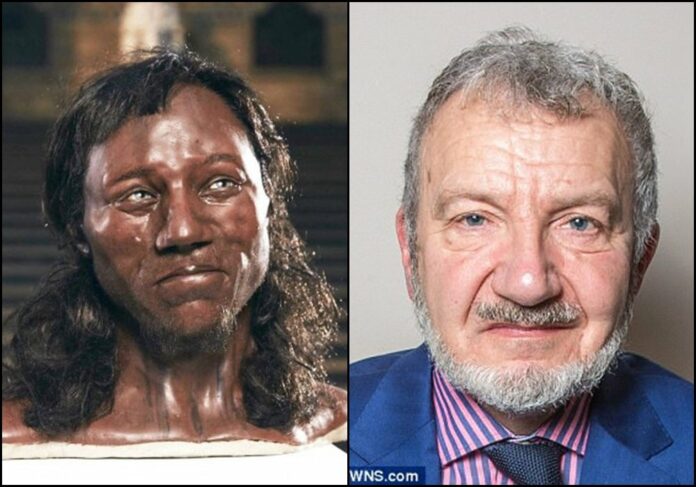Ancient ‘Cheddar Man’ Skeleton Shares DNA with Modern English History Teacher!

In an astonishing twist of fate, a 9,000-year-old skeleton known as Cheddar Man has been found to share DNA with a living English history teacher, linking the two across nearly 300 generations. This extraordinary connection between past and present was discovered in the picturesque landscape of Somerset, England, where the ancient bones were unearthed over a century ago.
Discovery of Cheddar Man
Cheddar Man was discovered in 1903 in Gough’s Cave, nestled in the dramatic Cheddar Gorge cliffs of Somerset. The skeleton, believed to be around 10,000 years old, represents one of the earliest known inhabitants of Britain following the last Ice Age. Cheddar Man has long fascinated archaeologists and anthropologists, offering a rare glimpse into the lives of Mesolithic hunter-gatherers. However, the skeleton’s story gained new significance with the advent of ancient DNA research.
Life and Times of Cheddar Man
The landscape during Cheddar Man’s time was vastly different from today’s Britain. It was a wild and untamed post-glacial environment, requiring its inhabitants to adapt swiftly. The initial archaeological analysis revealed that Cheddar Man died in his twenties. These early insights provided a snapshot of a bygone era, but the full depth of Cheddar Man’s story remained hidden until the development of ancient DNA (aDNA) research.

The Rise of Ancient DNA Research
Ancient DNA research has revolutionized our understanding of human history, allowing scientists to extract genetic information from ancient remains and travel back in time. This field emerged in the latter half of the 20th century and has since evolved rapidly with advancements in sequencing technology and bioinformatics. By the early 21st century, aDNA research began to challenge long-held assumptions about human prehistory, revealing new insights into migrations, interactions, and adaptations.
Genetic Revelation
Cheddar Man was an ideal candidate for aDNA research due to his well-preserved remains. When his DNA was sequenced, the findings were groundbreaking. Contrary to the long-held image of pale-skinned, blue-eyed hunter-gatherers, Cheddar Man’s genetics indicated he had dark skin and blue eyes. This revelation transformed our understanding of Mesolithic Britons and underscored the complexity and fluidity of human genetics over millennia.
The Connection to Adrian Targett
The story took an even more intriguing turn when scientists discovered that Adrian Targett, a retired history teacher from Somerset, shares DNA with Cheddar Man. This connection was identified using genetic material extracted from one of Cheddar Man’s molar teeth. The analysis revealed that Targett is a direct descendant of Cheddar Man, tracing their shared ancestry back nearly 300 generations.
Targett’s reaction to the revelation was a mixture of surprise and amusement. He noted a family resemblance, particularly in their blue eyes and similar nose shape. This genetic connection between a modern individual and an ancient ancestor highlights the continuous thread of human existence, woven through the fabric of our DNA.
Broader Implications of aDNA Findings
Cheddar Man’s genetic profile also provides broader insights into the Western European hunter-gatherer population. His DNA showed traits such as lactose intolerance, light-colored eyes, and dark skin, which challenges previous assumptions about the evolution of skin pigmentation. It was previously thought that lighter skin evolved around 40,000 years ago as human populations moved north from Africa. However, Cheddar Man’s dark skin suggests that genes for lighter skin began to spread only about 8,500 years ago.

This aligns with research indicating that early European hunter-gatherers interbred with incoming farmers from the Middle East, who carried genes for lighter skin. These interactions and migrations significantly influenced the genetic landscape of modern Europeans.
Modern Significance and Further Research
The discovery of Cheddar Man’s genetic profile has led to a forensic reconstruction of his facial features, skin, eye color, and hair texture. This reconstruction, based on cutting-edge genetic technology, revealed a man with dark skin, bright blue eyes, and dark hair. Previous reconstructions had inaccurately depicted Cheddar Man with white skin and brown eyes, showcasing the power of modern genetic research to correct historical inaccuracies.
Cheddar Man’s story is not unique. Many modern Britons share genetic ancestry with the Western European hunter-gatherer population, from which Cheddar Man sprang. Genetic studies indicate that about 10 percent of the genetic makeup of contemporary Britons can be traced back to these ancient populations.
Conclusion
The tale of Cheddar Man and Adrian Targett is a compelling reminder of the intricate tapestry of human evolution. Our history is not only recorded in books and artifacts but also inscribed in our DNA. As aDNA research continues to advance, it promises to unveil even more secrets of our past, offering profound insights into the migrations, adaptations, and interactions that have shaped humanity.
Cheddar Man’s legacy serves as a potent reminder that our connections to the past are deep and enduring. His story bridges the gap between ancient history and the present, illustrating the continuous and ever-evolving journey of human existence. As we continue to explore the genetic heritage of our ancestors, we gain a deeper appreciation for the complex and dynamic nature of human evolution.
Video
News
The Hanging Temple: China’s 1,500-Year-Old Cliffside Marvel of Faith and Engineering
The Hanging Temple: China’s 1,500-Year-Old Cliffside Marvel of Faith and Engineering Perched precariously on the cliffs of Mount Heng in Shanxi Province, China, the Hanging Temple, also known as Xuankong Temple, Hengshan Hanging Temple, or Hanging Monastery, is an architectural…
The Willendorf Venus: A 30,000-Year-Old Masterpiece Reveals Astonishing Secrets
The Willendorf Venus: A 30,000-Year-Old Masterpiece Reveals Astonishing Secrets The “Willendorf Venus” stands as one of the most revered archaeological treasures from the Upper Paleolithic era. Discovered in 1908 by scientist Johann Veran near Willendorf, Austria, this small yet profound…
Unveiling the Maya: Hallucinogens and Rituals Beneath the Yucatán Ball Courts
Unveiling the Maya: Hallucinogens and Rituals Beneath the Yucatán Ball Courts New archaeological research has uncovered intriguing insights into the ritual practices of the ancient Maya civilization. The focus of this study is a ceremonial offering found beneath the sediment…
Uncovering the Oldest Agricultural Machine: The Threshing Sledge’s Neolithic Origins
Uncovering the Oldest Agricultural Machine: The Threshing Sledge’s Neolithic Origins The history of agricultural innovation is a fascinating journey that spans thousands of years, and one of the earliest known agricultural machines is the threshing sledge. Recently, a groundbreaking study…
Nara’s Ancient Sword: A 1,600-Year-Old Protector Against Evil Spirits
Nara’s Ancient Sword: A 1,600-Year-Old Protector Against Evil Spirits In a remarkable discovery that has captured the attention of archaeologists and historians alike, a 7.5-foot-long iron sword was unearthed from a 1,600-year-old burial mound in Nara, Japan. This oversized weapon,…
The Inflatable Plane, Dropped Behind the Lines for Downed Pilots
Experimental The Inflatable Plane, Dropped Behind the Lines for Downed Pilots The Inflatoplane from Goodyear was an unconventional aircraft developed by the Goodyear Aircraft Company, a branch of the renowned Goodyear Tire and Rubber Company, also famed for the Goodyear…
End of content
No more pages to load











